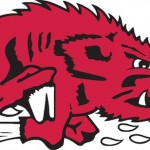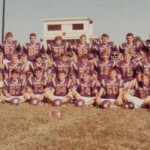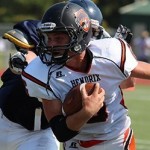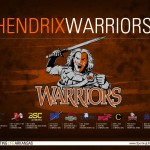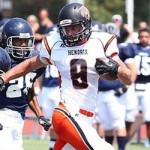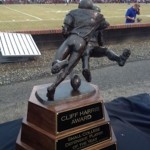In the final game of the 1960 football season, the Hendrix Warriors defeated the Ouachita Tigers, 7-6, in Arkadelphia.
Here’s how the Ouachita yearbook later described the game: “A large crowd, enjoying shirtsleeve weather, saw the two teams battle evenly through most of the game even though Ouachita passed up several golden opportunities to win the tilt. Hendrix drew first blood near the end of the first quarter on a long drive climaxed by a 12-yard jaunt to pay dirt by quarterback Cloyd Baltimore. Johnny Turner then added what was to prove to be the winning margin with the conversion.
“In the first quarter, Ouachita threw away what appeared to be a sure touchdown when Warrior end Mike Smith pounced on a Ouachita fumble. Later Tiger drives reached the 35- and 25-yard-lines of the visitors before being stymied. Ouachita finally scored late in the fourth period through the arm of quarterback Larry Pugh, who riddled the Warrior defense with passes. The tall freshman threw a 25-yard payoff pitch to halfback Tom Murphree in the end zone. However, end Carl Babcock of Hendrix blocked Ouachita’s attempt to tie the score.”
No Hendrix College team has played a football game since that day.
That will change on the afternoon of Saturday, Sept. 7, when the Hendrix Warriors host Westminster College from Missouri. Hendrix graduates are excited about the return of football to the school. Few people are more excited than those who once played football for the Warriors.
Ron Pyle was a member of that 1960 Hendrix team. He’s among those who believe it’s high time for intercollegiate football to be played again at the small Methodist school following a 53-year hiatus.
“I guess you could say that Hendrix has a one-game winning streak going into this year,” Pyle says, referring to the 1960 win over Ouachita. “Through the years, many of us have stayed close, and all of us regret not being able to come back for another season. A strong bond was established. It’s very satisfying to see the return of football at Hendrix. I learned the lessons of facing adversity, never giving up and working with teammates as a Hendrix football player.”
Pyle, who transferred to Hendrix his sophomore year, says the team was small – both in numbers and individual size.
“There weren’t a lot of us, and we only had one really big lineman, Marvin Gillham,” he says. “We generally were underdogs, but every game we played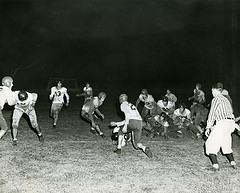 was with a sense of determination. We played to win. One moment of brief success occurred during my junior year when we went to play Arkansas Tech, which was an Arkansas Intercollegiate Conference powerhouse at the time. We had worked on a trick play for a kick return. My job was to drift to the left. Jerry Jeffries would receive, go right and draw the Tech defense to him. He would then pull up and pass the ball across the field to me. The pass had to qualify as a lateral. It worked perfectly. I followed Marvin 80 yards for a touchdown. We led Tech at the half, 7-6. The Tech coach was not happy, and we could see him chewing out his team, in particular an All-American named ‘Tiger’ McClellan.
was with a sense of determination. We played to win. One moment of brief success occurred during my junior year when we went to play Arkansas Tech, which was an Arkansas Intercollegiate Conference powerhouse at the time. We had worked on a trick play for a kick return. My job was to drift to the left. Jerry Jeffries would receive, go right and draw the Tech defense to him. He would then pull up and pass the ball across the field to me. The pass had to qualify as a lateral. It worked perfectly. I followed Marvin 80 yards for a touchdown. We led Tech at the half, 7-6. The Tech coach was not happy, and we could see him chewing out his team, in particular an All-American named ‘Tiger’ McClellan.
“Tech kicked off after the half. There were 20 Hendrix and Tech players on the left sideline for the return and just two players on the right, me and a very angry ‘Tiger’ McClellan. He punished me severely. I didn’t care. We eventually lost, 26-7, but for a half it was great.”
The game was an afternoon contest in Russellville. Powell ‘Tiger’ McClellan was named as a second-team Little All-America as an end that year. The NAIA picked offensive and defensive All-America teams for the first time that season, and McClellan was named to the first team as a linebacker. As a senior in 1961, McClellan moved up to first team Little All-America as an end. He was named first-team NAIA All-America as a defensive end.
Longtime Little Rock CPA Jim Rasco, who is a Hendrix graduate and serves as the historian for the Arkansas Sports Hall of Fame, attended the game in Russellville. He vividly remembers the play on which Pyle scored.
“What Tech didn’t know was that Hendrix really didn’t have a placekicker at that time,” Rasco says. “Hendrix lined up for the extra point kick, but the ball was snapped to kicker Mike Smith. He then passed the ball to a wide open Jerry Carter for the extra point. There were no two-point conversions under NAIA rules in 1960 so Hendrix led 7-6 at the half. ‘Tiger’ McClellan blocked at least two of Carter’s punts in the second half.”
Hendrix began playing football in the early 1900s. The original mascot was the Bulldogs. The old American Indian image for the Hendrix Warriors has given way to a sort of Celtic warrior in recent years. Despite all the changes, there’s a solid football tradition at the school.
Charles Tadlock of Sheridan, who played at Hendrix in the late 1950s, says he has “always been jealous of my Ouachita friends who have had the opportunity to attend football games at their alma mater on fine fall Saturday afternoons.”
Now, Hendrix graduates such as Rasco, Tadlock and Pyle will be able to enjoy the experience.
“The 1920s and 1930s were outstanding periods for Hendrix sports with numerous all-sports stars and games against major universities,” Tadlock says. “The AIC got stronger after World War II with some of the colleges going from having two-year programs to having four-year programs. As scholarships increased at the other schools, Hendrix found it harder to compete and dropped football for the 1956 season. The sport was reinstated in 1957 with half-tuition scholarships.
“The team gradually improved from 1-7 the first year back to 3-5-1 in that fourth season of 1960. There were 22 freshmen in 1957. Only four of those players were still on the team in 1960. There were about 40 total players. Things appeared to be pretty bright for the 1961 season, but the school dropped the sport due to financial troubles. Most of the players were bitter about the end of the football program. During the 53 years when there were no football teams, Hendrix went from being an NAIA school with six sports to being an NCAA Division III school with 21 sports.”
Jeffries, a member of the 1960 team, says that while it’s not the old AIC, “it’s still 11 men against 11 men. I think having football again will round out the Hendrix experience for the young men who play. They’ll get the education Hendrix is noted for and a chance to continue playing a game they love. I have no doubt it will be a first-class program all the way.”
In the trophy case of the school’s ultramodern Wellness & Athletic Center, there’s a football that was used in a 7-6 Hendrix victory over Ouachita. It’s not from that final game of 1960, though. It’s from a Nov. 1, 1929, game that marked the first Hendrix win over Ouachita in 19 years. While plenty of people are around who remember the 1960 victory, it obviously would be much more difficult to find anyone who was at the 1929 game.
Meanwhile, there’s no one left to give an account of perhaps the most momentous win in the history of the Hendrix football program, a 1913 victory over Ole Miss. One of the best teams ever at Hendrix later would play a scoreless tie with Ole Miss in 1927. Hendrix played the University of Arkansas in football several times. The Arkansas-Hendrix game was billed in 1926 by newspapers as the “state championship,” and the Razorbacks won, 14-7. The Razorbacks then defeated Hendrix, 20-7, in the final game of the 1927 season. Hendrix never beat the Razorbacks but did hold the Hogs to scoreless ties in 1920 and 1932.
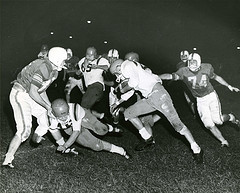 The most famous figure in Hendrix football history probably was Coach Ivan Grove. The legendary coach spent two years in the Army during World War 1, graduating from Henry Kendall College (now the University of Tulsa), where he led the nation in scoring. Francis Schmidt (who compiled a record of 41-21-3 as the Razorback head coach from 1922-28) had been Grove’s high school coach at Arkansas City, Kan. Schmidt was an assistant at Henry Kendall when Grove played there. After college, Grove coached two years at Oklahoma Baptist College and then was hired by Schmidt as an assistant coach of the Razorbacks. At age 30 in 1924, Grove took over at Hendrix and coached until 1957. From 1924-27, his Hendrix teams went 23-9-3.
The most famous figure in Hendrix football history probably was Coach Ivan Grove. The legendary coach spent two years in the Army during World War 1, graduating from Henry Kendall College (now the University of Tulsa), where he led the nation in scoring. Francis Schmidt (who compiled a record of 41-21-3 as the Razorback head coach from 1922-28) had been Grove’s high school coach at Arkansas City, Kan. Schmidt was an assistant at Henry Kendall when Grove played there. After college, Grove coached two years at Oklahoma Baptist College and then was hired by Schmidt as an assistant coach of the Razorbacks. At age 30 in 1924, Grove took over at Hendrix and coached until 1957. From 1924-27, his Hendrix teams went 23-9-3.
Despite Grove’s later success, the 1913 win over Ole Miss still stands out as a landmark victory in the annals of Hendrix football.
“Ole Miss, the gridiron team which is dreaded by all Southern colleges, will arrive in Conway for a battle with the Hendrix College football aggregation,” the Log Cabin Democrat at Conway reported at the time. “The record on the scalping path made by Ole Miss this season, as well as past seasons, is a source of much pleasure to their fellow students, while on the other hand they invariably leave many mourners behind them.”
The writer didn’t have that kind of praise for the Hendrix football team.
Instead, he wrote: “Hendrix continues to go through practice antics every afternoon, but there is a noticeable lack of pep and ginger among the squad.”
By the week of the game, though, the Log Cabin Democrat was beating the drums: “The most stupendous football game played in Arkansas this season will be staged tomorrow afternoon at 3:30 o’clock on Hendrix field between the elevens representing the University of Mississippi of Oxford, Miss., and Hendrix College of this city. Never before in the history of the gridiron pastime has there been more enthusiasm among the people – not only of this city but over the state – than has been displayed already over tomorrow’s engagement. On every corner, in every store, in every nook – and, in fact, at every place where there are as many as two persons – the sole topic of conversation concerns tomorrow’s football game.”
By the time the sun had set on Conway on Nov. 7, 1913, Hendrix had come away with a stunning 8-6 victory.
Southern Methodist University had fielded its first team in 1913, losing the first game to TCU and then beating Hendrix by a score of 13-2 in the second game in school history. Ole Miss was not so lucky. More than 200 Hendrix male students – accompanied by the school’s band — marched through downtown Conway that night after the win over Ole Miss. The men were dressed in pajamas. They made their way to Central College, a school for women that was located on what’s now the campus of Central Baptist College. Women waved at them from the windows of their rooms.
On the first Saturday in September – a century after that victory over Ole Miss – Hendrix will host a college football game. It’s doubtful that the male members of the student body will parade through the streets of Conway if the Warriors defeat Westminster. But there’s no doubt that excitement is building in Conway.
Vance Strange, a former University of Central Arkansas athletic director and a former president of the Arkansas Sports Hall of Fame, says it best when it comes to the buildup to the 2013 Hendrix season. Strange, who played football at Hendrix, often has his morning coffee at Bob’s Grill, the venerable eatery on Oak Street in downtown Conway where local residents gather to talk sports, politics and the weather. Strange uses something he calls the “Bob’s Grill gauge” to monitor what interests folks in the area.
“At Bob’s, I can assure you that people are excited about Hendrix football,” he says matter of factly.
It should be noted that the Bob’s Grill gauge is rarely wrong.



